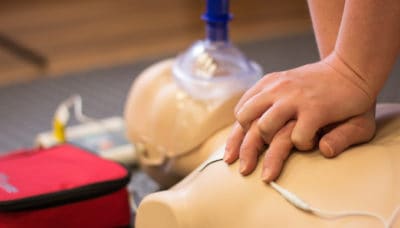Introduction
In today's busy work environment, safety and security is vital. learn CPR Sydney Olympic Park Organizations are significantly recognizing the relevance of creating a risk-free space for workers. One of one of the most essential components of work environment safety and security training is first aid and CPR (Cardiopulmonary Resuscitation) programs. These programs not only equip workers with important life-saving abilities however additionally cultivate a culture of safety and security within the organization. In this article, we will look into the myriad reasons why workplace safety training ought to include emergency treatment and mouth-to-mouth resuscitation programs, underscoring their relevance in boosting office safety.

Why Workplace Safety and security Training Ought To Consist Of First Aid and CPR Courses
The combination of first aid and CPR training courses right into office security training has significant benefits. They equip employees with the knowledge and abilities required to react efficiently to medical emergencies, minimize healing time for hurt people, and potentially save lives. Additionally, having trained employees on-site can impart self-confidence amongst staff members and assure them that their well-being is prioritized.
Understanding First Aid
First help refers to the prompt treatment provided to an individual suffering http://erickyqdu741.image-perth.org/crucial-cpr-courses-near-me-what-you-required-to-know from a minor or serious health problem or injury up until professional clinical aid gets here. Recognizing fundamental first aid concepts can make a considerable distinction in emergency situations.
Key Parts of First Aid
Assessment: The ability to assess a scenario rapidly can help identify the ideal actions needed. Stabilization: Understanding exactly how to maintain an injured individual prevents more harm. Communication: Efficiently interacting with emergency services is important for timely assistance.The Value of CPR
CPR is a life-saving method made use of in emergency situations when somebody's heart beat or breathing has actually stopped. It includes chest compressions and rescue breaths to maintain blood flow and oxygenation until expert help arrives.

How mouth-to-mouth resuscitation Works
- Chest Compressions: These help flow blood throughout the body. Rescue Breaths: These offer oxygen to the lungs.
Benefits of Emergency treatment and CPR Certification
Obtaining an emergency treatment certificate or completing mouth-to-mouth resuscitation courses includes countless advantages, both for individuals and organizations.
Enhanced Staff member Confidence: Workers feel extra safe and secure understanding they have life-saving skills. Reduced Recuperation Time: Quick reaction through emergency treatment can cause far better results for hurt individuals. Compliance with Regulations: Lots of industries need certified employees as component of their health and safety regulations.Creating a Culture of Safety With Training
Implementing emergency treatment and mouth-to-mouth resuscitation training promotes a society that focuses on worker well-being.
Encouraging Teamwork
Training sessions typically entail team-building workouts that boost cooperation amongst employees.
Building Count on In between Staff members and Management
When monitoring buys staff member training, it reveals commitment to their wellness, leading to boosted morale.
First Help Surges vs. Mouth-to-mouth Resuscitation Courses: What's the Difference?
While both kinds of training courses are important, they concentrate on various ability sets.
First Help Courses
These programs cover a vast array of topics beyond just cardiac emergency situations, consisting of:
- Wound care Burns Choking
CPR Courses
CPR programs especially concentrate on techniques related to heart attack situations, emphasizing:
- Adult CPR Child/ infant resuscitation Use of an Automated External Defibrillator (AED)
Choosing the Right Training Provider
Not all training carriers are produced equivalent; as a result, picking First Aid Course Hobart one that satisfies your company's demands is critical.
Accreditation Matters
Ensure that your selected supplier offers approved programs identified by appropriate authorities.
Instructor Experience
Consider teachers' credentials; experienced trainers typically offer richer knowing experiences with real-world examples.
Incorporating Emergency treatment into Work Environment Security Policies
Organizations ought to incorporate emergency treatment demands into their wider safety and security plans for comprehensive coverage.
Regular Training Updates
Conducting regular refresher courses ensures that understanding continues to be current amongst employees.
Creating Emergency Reaction Plans
Having clear plans in place can guide qualified workers during emergencies.

Legal Effects of Emergency treatment Training in the Workplace
Employers have lawful obligations regarding work environment security; executing emergency treatment training can help mitigate dangers connected with non-compliance.
Negligence Claims
Failure to give appropriate training might leave companies prone to suits if a case takes place as a result of absence of preparedness.
FAQ Section
What is consisted of in a typical first aid course?- A regular emergency treatment course includes guideline on analyzing injuries, dealing with wounds, managing burns, managing choking cases, and carrying out CPR if necessary.
- Most CPR training courses last in between 4-- 6 hours depending on whether it's basic or advanced training.
- While not always legitimately mandated, having accredited team member can dramatically boost workplace security standards.
- Many accredited companies supply online renewal alternatives for first aid certifications which include analyses using video clip conferencing.
- Yes, markets such as building, health care, education, and manufacturing often have regulatory demands demanding qualified personnel on site.
- It's advised that workers participate in refresher courses every two years or quicker if there are considerable changes in procedures or regulations.
Conclusion
To summarize, incorporating emergency treatment and CPR right into workplace safety and security training is not just an alternative but a need in today's work environments where emergency situations can emerge at any moment. Organizations advantage tremendously from having trained personnel ready to react efficiently during situations while promoting an ambience where staff member health takes precedence over all else. As a result, it ends up being obvious why workplace security training need to consist of first aid and mouth-to-mouth resuscitation courses-- they conserve lives while promoting a positive method toward health and wellness standards within companies across various sectors.
By prioritizing such essential training initiatives-- first aid certificates acquired through reliable companies together with useful hands-on experience-- firms can substantially enhance their general emergency readiness levels while likewise building stronger groups efficient in tackling any scenario head-on!